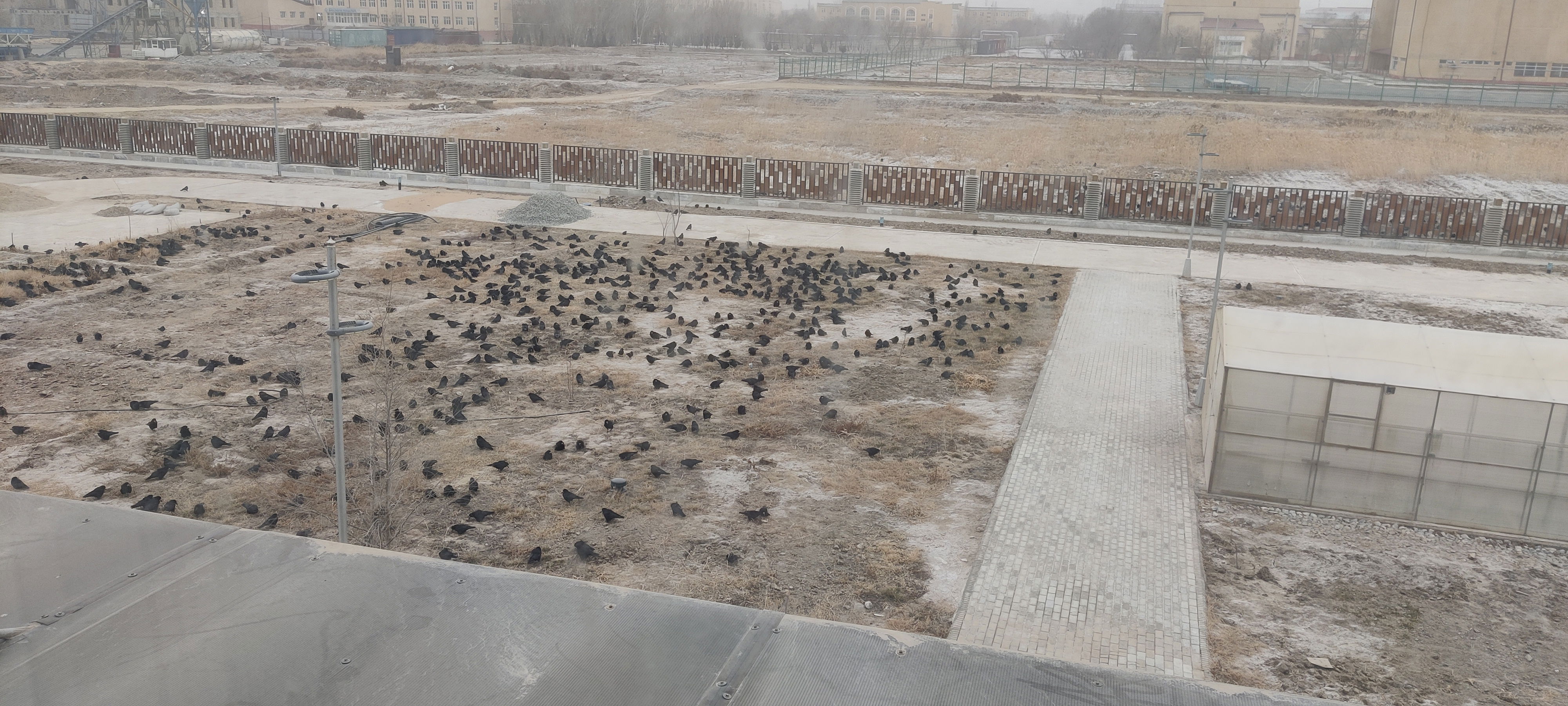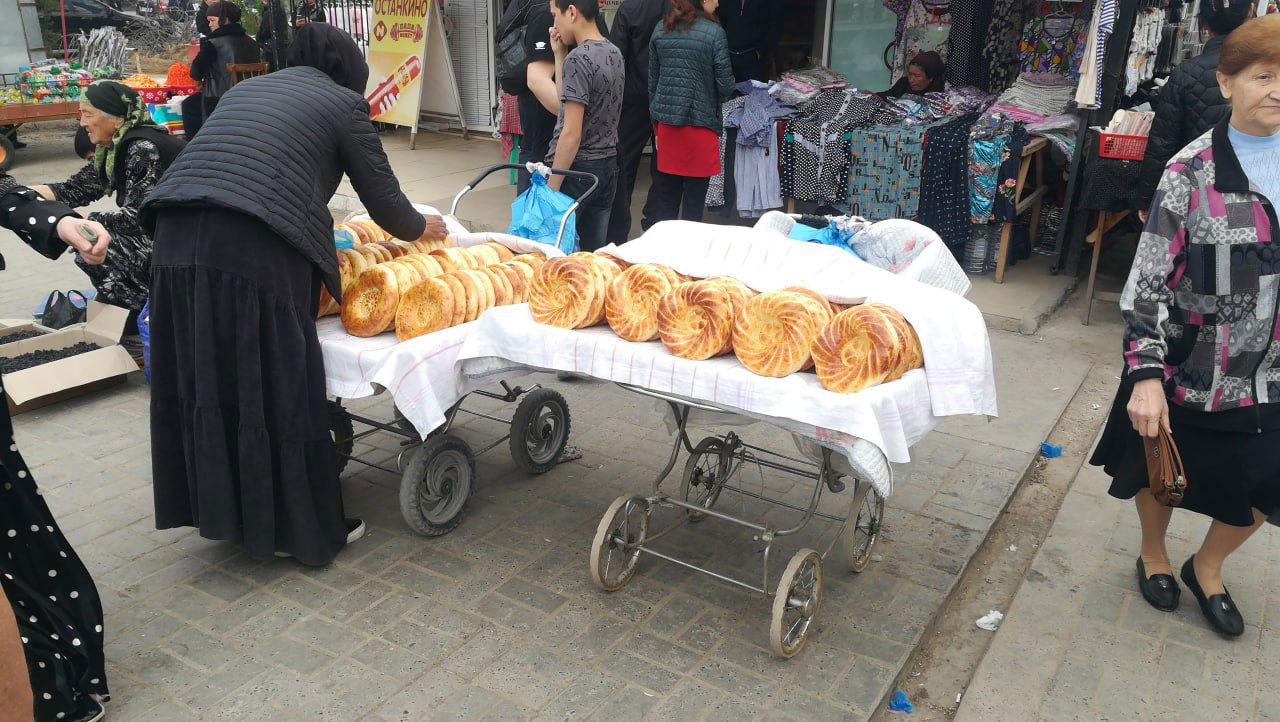A Murder of Crows ... and Bread Baskets!
One of the best things that we have been gifted with is our ability to walk and to observe what is happening in life all around us. This comes totally free of charge and it is flexible, so we can fit it into our schedules. In Uzbekistan, this a gift that keeps on giving.
I always stroll around my neighborhood with the assumption in the back of my mind that there is never nothing happening. All I need to do is to keep my eyes and mind open.
When walking along any of the main streets of town, one of the most notable sights are the street vendors with their tiny tables and even tinier collapsible seats. The vendors are usually old ladies who have their regular spots which, in my mind, turns them into convenient local landmarks. I could give someone directions along these lines, “Go to the first vendor, she is on the corpulent side, her little chair is almost invisible under her ample behind. But don’t be fooled – it’s there. From her table, continue for another block and you will see another lady. She always wears a gray vest and a colourful scarf tied around her head. Facing her, turn left and you are almost there.” Wherever ‘there’ is.
Many of these street vendors sell an assortment of individual cigarettes spread out on the table next to school supplies of pens, pencils and notebooks. What’s the idea here? Buy yourself a notebook and receive one cigarette free? Unfortunately, Uzbekistan is just like most of the Asian countries. The majority of men here are heavy smokers. But at least the Western health propaganda has seeped through and ensured that most restaurants don’t allow smoking indoors. Most, but not all. The only Korean restaurant in Nukus, its exclusiveness making it the best and, therefore, one of our favorites, allows smoking in the main section with the non-smoking section being much smaller. The two sections are divided only by an imaginary line. The proportion of smoking and non-smoking space speaks volumes. But we love the food and, as we sit in our small non-smoking section practically by ourselves, between inhaling second-hand smoke and chewing, we tell ourselves how wonderful it is to have so much privacy.
Because of its proximity to our school, I walk the local university grounds quite often. One area always makes me pause and observe the scenery a bit. But never with my mouth gaping. The area has too many birds flying overhead to make that mistake. The narrow cement path is covered with thousands of droppings, and creates the illusion of a marble-like surface. It is bounded on both sides by rectangular areas populated with mature trees. These serve as a base for about thirty crow’s nests. Since the campus has a nice ornamental fence around its grounds, I have come to think of the crows’ area as a gated community, where every crow lives in a penthouse. I’d already known about the existence of the nests last fall because I could hear crows harsh, distinct cries. But I could not get a good look because they were protected by foliage. This changed over the winter. The leaves fell, and many of the crows disappeared. But not all. The more determined ones stayed. Maybe they refused to leave their homes for fear that, upon their return, they might find squatters on their properties. Come March, the scene changed again. The nests, still fully visible, again showed a large colony of crows. It’s a vibrant neighborhood with lots of squabbling noise. On several occasions I even witnessed occasional physical spats. It made me wonder. Do they fight over nests that have a better view, or the ones that are larger? After all, they are all exclusive penthouses.

The crows’ area, as I have come to think of it, is separated from the wooded area preferred by smaller songbirds by a wide brick path leading from the street to the Faculty of Law. These two areas and their feathered populations are quite distinct.

In the past someone attempted a forced integration by idealistically placing ten bird houses on the trees in the crow’s area, intended for songbirds. The crows shun them because they prefer their messy nests and because, even after a strict diet, they could not squeeze into the houses. And the songbirds don’t take possession, probably because they feel uncomfortable living right under the big guys. Or maybe the crows turned out to be NIMBY (not in my backyard) types.
The first time I came across this term (NIMBY) I lived in Toronto, and the Toronto Star newspaper carried an article about the plight of city officials trying to place a half-way house in some neighborhood.
Everybody agreed that the idea of giving people a second chance, and trying to integrate them back to society, was a sound one. But when it came to actually placing such a house in a regular neighborhood, all hell broke loose, with neighborhood committees exercising their right to oppose any such proposal. Maybe crows, just like people, have the same NIMBY sentiment amongst them. Whatever the reason, the nice, tidy houses provided by well-meaning people intended to gentrify the messy crow neighborhood remain unoccupied. The songbirds and the crows stubbornly maintain segregation. I may not appreciate the crows’ harsh cries, but I respect their intelligence. Crows are known for their ability to use tools if needed. I am not talking hammers and drills, just twigs and pebbles. Still, it’s impressive since they don’t look all that smart.
In that respect, crows and people are similar, always trying to find ways to make their lives easier (even though they may not look all that smart!). When some clever Sumerian placed an axel into a round block of wood for the first time, he probably had no idea that his invention would revolutionize transportation. Several thousand years later we still use wheels to help us get material and people from one place to another. In Uzbekistan wheels come attached to all kinds of contraptions that serve one purpose, to ease the burden of transporting different wares. My favorite ones are old baby strollers, looking like something from the sixties; deep oval carriages set on big thin-rimmed wheels. I would not be surprised to find out that some of the women pushing these strollers had been their original passengers. I often see the women walking around the neighborhood, pushing the strollers usually packed with bottles of milk. As they walk, they periodically cry out what I imagine to be ‘Come you thirsty people, fresh milk has arrived.’ The same strollers are also present in the market, in this case loaded with fresh local bread.

Invariably, in the vicinity of the market, I also see men pulling big carts with thick-tired wheels loaded with heavy stuff destined for the market stalls. I know they are heavy because, on several occasions, I have seen them get stuck over small bumps, uneven surface of the road. Luckily, there are always willing passersby to help them get over these obstacles.
Recently, while walking backstreets behind apartment buildings, I saw a man pushing his bike slowly and occasionally shouting some words. I did not understand the words, but I noticed a box rigged to the back of his bike, so I was reasonably sure that he was not mentally challenged, nor inebriated, just trying to sell something. I approached him and asked him to show me what was hiding under the tea towel protecting something in the box. In the split second before he uncovered his wares I already knew by the smell. It was a box full of fresh fish!
Walking around the neighborhood may not be for everybody, but I really enjoy it knowing, from my past forays, that there’s always something happening that has the potential to amuse me or to teach me something. It rarely disappoints.
(Oh, the pic below is just for some additional levity!)
